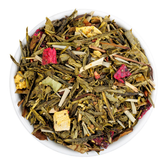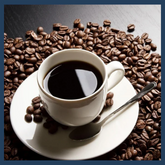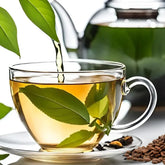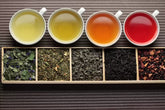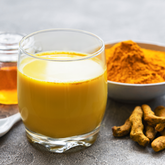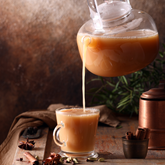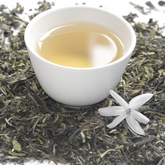FROM BLACK TO WHITE: LEARN ABOUT DIFFERENT TYPES OF TEA
Legend has it that over 4700 years ago a fortuitous blunder caused a few dry leaves to accidentally fall into a pot of boiled water being prepared for an emperor in the hills of China. Since that time tea has exploded into the most popular beverage on the planet (other than water). An out-and-out quest has been undertaken to discover which leaves on which plants brew the best tea.
After millennia of exploring, discovering and experimenting, the world of tea has become more vast and specialized than fine wine. Most wine is made from grapes and is generally classified as red, white and rose. Likewise, all tea comes from the tea bush Camellia Sinensis and is generally either Black, Oolong, Green or White. A fifth main category, herbal is technically not tea, as "herbal tea" refers to the world of wonderful infused beverages made from plants other than Camellia Sinensis. Sometimes the more precise word "tisane" may be used when refering to herbal infusions.
BLACK TEAS
Black tea is the most intensively processed type of tea. The leaves are allowed to fully oxidize, creating their black color before they are dried, giving black tea more complexity, more astringency and fewer vegetal overtones than are typically found in other teas. Astringency is the "dry mouth" sensation left by tannins in tea, familiar to drinkers of a cabernet sauvignon, or other wine. It is this astringency that pairs so nicely with dairy and sweetener. Achieving the right balance of astringency is one of the leading indicators of quality in a black tea.
While the name refers to the color of the leaves, the liquor produced from brewing is generally reddish-orange-brown in color. Good black tea can usually be steeped hotter, longer and stronger than other tea types, which is one reason that black tea contains the most caffeine per cup.
At Stille Tea, black tea blends abound. Some are straight and pure from the cupping; while others are blended with subtle hints of peach, wild cherry, blackberry, vanilla and even pomegranate. While black teas have also been grown in regions of Turkey, Russia, Azerbaijan, Kenya and Indonesia, our tea comes from the leading tea producing nations of China, India and Sri Lanka.
GREEN TEAS
Green Tea, best known for its grassy vegetal notes and greenish liquor and leaves, is quickly steamed or pan-fired to denature the oxidizing enzymes, and to preserve its characteristic freshness. Without oxidation however, green teas must be steeped more carefully, as they can become bitter if steeped too long or at too hot a temperature. Green tea should never be steeped with boiling water. Near boiling or even cooler will produce much better results.
Among our notable green teas is the distinctive Moroccan Mint or Gunpowder tea, so named for its resemblance to actual gunpowder. Individual leaves are roasted in a pan, then hand-rolled into pellets resembling the gunpowder pellets used in British cannons. Other green teas, including ours, are known for having additional flavors incorporated into their blends.
Finally, no discussion on green tea would be complete without mentioning the one tea with which we are probably most familiar, Japanese-style Sencha. For many, a taste for green tea was formed at a favorite Asian restaurant where Sencha is often served at the end of an artfully created repast. Dubbed as as the White Whine Of Teas, Sencha warms the soul, cleanses the palate and remains one of our favorite greens.
WHITE TEAS
While white teas are "less processed" than greens, they are actually usually somewhat more oxidized. Mild oxidation occurs during the "wilting" stage, when white tea is air-dried after it is first picked. It is then baked, dried further, and it may be very lightly rolled, but little is done to change what was picked from the plant. Because white teas are slightly oxidized they don't usually need to be steeped as carefully as greens. Unlike green tea, steeping white tea with boiling water, or for a longer time period or time, will still produce good results.
Grown mostly in the famous Fujian province white teas have several well-known and rare blends. The most famous is Bao Hao Yinzhen or "Silver Needles". White tea is picked between March 15 and April 10 when precipitation is at its lowest, insuring a fair amount of undamaged and unopened buds. This is a very high grade tea and one of the most sought after, prized and revered blends for the tea connoisseur.
While green and black teas have been flavored and scented for centuries, flavored white teas are a relatively new creation. We have found that white tea enhances other flavors, and consider our Mango White blend to be among our most innovative.
OOLONG TEAS
HERBAL TEAS
Herbal teas include herbs, flowers, berries, spices, roots, fruits or other flora sources. Long used for their medicinal qualities, most of the ingredients in our herbal teas have been consumed for centuries, even millennia. Herbals include such classic remedies as nausea-reducing ginger and sleep-inducing chamomile, as well as more exotic flavors like rooibos: a South African staple that produces a deep red and deliciously floral elixir that is at least as antioxidant-rich as any tea, yet naturally caffeine-free.
All are wonderfully unique and naturally caffeine-free and suited for anyone, at any time of day. In short, herbal teas open up a whole new vista in the palate of possibilities.







